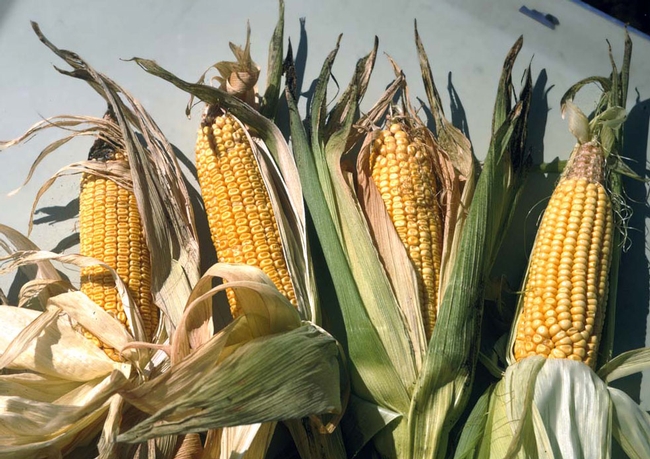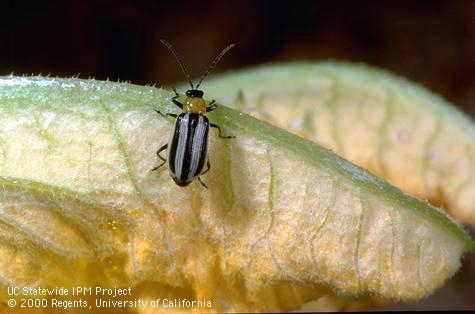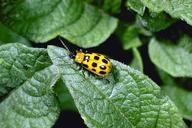Posts Tagged: Corn
2017 Kearney Alfalfa and Forage Field Day Presentations Now Available On-Line
As the alfalfa hay harvest season wraps up and we get in gear to attend the November 2017 Western Alfalfa and Forage Symposium in Reno, NV, we're...
'More crop per drop' drought strategy touted
Corn silage producers can get 'more crop per drop" with deficit irrigation, however productivity will decline, reported Dennis Pollock in Western Farm Press. Pollack based the story on a seminar at the World Ag Expo earlier this month presented by Mark Lundy, UC Agriculture and Natural Resources Cooperative Extension advisor for Colusa, Sutter and Yuba counties.
Lundy said there are certain times in the crop's development that farmers will not want to stress the corn silage - when tassels and silk are forming. At other times in its development, even if the corn is stressed, the application of more water does not bring a proportionate increase in yield.
The UC ANR advisor suggested farmers choose planting dates, varieties and cultural practices that will maximize irrigation efficiency.
“Look at what you choose to grow and perhaps plant later with a short variety or drought tolerant variety,” he said. “And get weeds under control. They take up water.”
Alfalfa & Forage Field Day at Kearney Ag Center
Mark your calendar for Thursday September 5th and plan to join fellow growers, PCAs, and seed and chemical company reps at our annual Alfalfa and...
Alfalfa and Forage Sept 5 KAC Meeting flyer
Corn Rootworms Outwit Genetically Modified Seed
My genealogical roots deep run through many a corn field since I was born from a Nebraska-farm girl mother and an Indiana-raised father. Field corn. Popcorn. Sweet corn. You name the corn, my relatives planted it. Several decades back I even grew ornamental corn one summer to decorate Christmas wreaths. So needless to say I was riveted to a recent Wall Street Journal article about how Mother Nature is outsmarting genetically modified corn seed. (Ian Berry, “Pesticides Make a Comeback”, Wall Street Journal, May 22, 2013, p. B-1.)
Seems that entomologists at the University of Illinois and Iowa State University found corn rootworms immune to Monsanto’s Bt (Bacillus thuringiensis) gene. That gene was originally designed to shield corn crops from this pest that feeds on leaves, tassels and silks; injures roots and can stunt or kill young shoots and plants.
The article also points out that last year America’s farmers planted 97 million acres in corn based on increasing prices and EPA approval touting reduced insecticide use that would give growers and farm workers “greater safety, protect water bodies from runoff and mitigate” harm to wildlife.
“Some of those gains are quickly being reversed,” said Michael Gray, a UI entomologist quoted in the story, who went on to say that next year over a quarter of corn farms plan to use insecticides as “cheap insurance.”
Makes senses now why sales are up for pesticide producers. To read the entire article, log on to WSJ online or review a similar story “Pesticides make a comeback against Monsanto seed” at
http://www.bignewsnetwork.com/index.php/sid/214688991/scat/3de2685784ae51b
Frankly, I wanted to know exactly what this crawly critter chomping on corn crops looked like. During my research of “corn rootworms,” I discovered crop damage is not limited to larvae but includes the adult — two familiar beetles often found in our own backyard vegetable patch that also feeds on cucurbits, legumes and grasses — the Western striped cucumber beetle (Acalymma trivittatum) and the Western spotted cucumber beetle (Diabrotica undecimpunctata undecimpunctata). (See UC IPM Pest Management Guidelines: Corn, plus UC ANR Publication 3443. Also UC IPM Pest Management Guidelines: Curcurbits, plus UC ANR Publication 3445.)
Photos below are of the Western striped cucumber beetle and the Western spotted cucumber beetle).
And there’s more. In fact, there’s also a banded cucumber beetle (Diabrotica balteata) and a spotted cucumber beetle (Diabrotica undecimpunctata howardi), also known as the Southern corn rootworm. In addition, there’s the Northern corn rootworm (Diabrotica barberi Smith & Lawrence), and the Western corn rootworm (Diabrotica virgifera virgifera LeConte).
When you compare the above two photos with photographs on Purdue University’s IPM website, you’ll notice that our Western spotted cucumber beetle looks identical to the Southern corn rootworm and that our Western stripped cucumber beetle appears the same or similar to the female Western corn rootworm. Plus, there’s a photo of the larvae -- the actual rootworm. Here’s the Purdue IPM link:
http://extension.entm.purdue.edu/fieldcropsipm/insects/corn-rootworms.php
Companion Planting at it's Best
Along with gardening, I have an interest in American history, and combining the two can lead me to hours and hours of exploring and research. I grew up in Santa Rosa and visited Luther Burbank's garden many times. I've been privileged to meet people who knew him and relish in their personal stories and memories. Mr. Burbank's imprint in the botany world has much effect on our current day planting and output.
A fascinating piece of American gardening/history is the legend and practical application of The Three Sisters. Variations of this legend can be found in the ethos of many American Indian tribes, but is primarily attributed to the Iroquois. It is a wonderful example of companion planting and has proven to be one of the most effective techniques ever developed in gardening and farming. This method was was used by Native Americans then later taught to the early European settlers and is still used by many farmers and home growers today.
One version of the legend goes like this:
A long time ago, three sisters lived together in a field. These sisters were quite different from on another in their height and in the way they carried themselves. The little sisters was so young and round that she could only crawl at first and she was dressed in green. The second sister wore a bright sunshine yellow dress, and she would spend many an hour reading by herself, sitting in the sun with the soft wind blowing against her face. The eldest sister, standing always very straight and tall above the other, looking for danger and warning her siblings. She wore a pale green shawl and had dirty yellow hair. There was one way the sisters were all alike, though. They loved each other dearly, and they always stayed together. This made them very strong.
One day a strange bird came to the field; a crow. He talked to the horses and other animals, and this caught the attention of the sisters. Late that summer, the youngest and smallest sister disappeared. Her sisters were sad. Again the crow came to the field to gather reeds at the water's edge. The sisters who were left watched his trail as he was leaving, and that night the second sister, the one in the yellow dress, disappeared. Now the eldest sister was the only one left. She continued to stand tall. When the crow saw how she missed her sisters, he brought them all back together and they became stronger together again. The elder sister stands tall looking out for the crow to this very day. (Shelia Wilson, member of the Sappony Tribe)
The practicalities go like this:
The first sister is corn. She grows tall and provides a pole for the beans which shore up the corn stalks and leave behind nitrogen for the soil. The third sister, squash, shades the bed from weeds and helps the soil retain moisture. Some seed catalogs actually sell packets of three seeds together along with specific directions on how to plant. The method used by Native Americans for hundreds and hundreds of years is still the recommended method.
On June 3, 2011, Cherokee White Eagle corn, Rattlesnake pole beans, and Seminole squash seeds, all donated by the National Museum of the American Indian, were planted at the White House Kitchen Garden by a group of American Indian and Alaska Native youth. According to the First Lady, Michelle Obama, "It turned out to be one of our most successful plantings in the garden."




